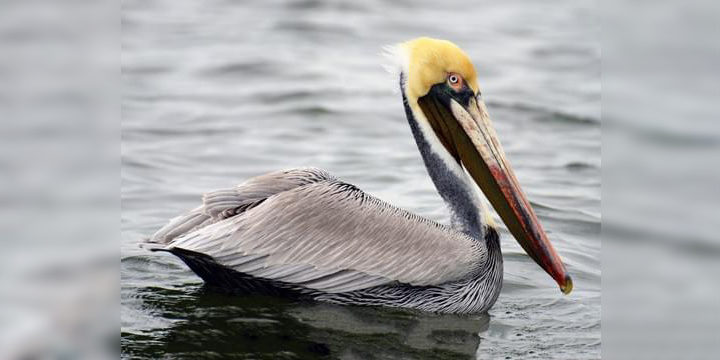Bird of The Week: Brown Pelican
SCIENTIFIC NAME: Pelecanus occidentalis
POPULATION: 650,000
TREND: Increasing
HABITAT: Atlantic, Pacific, and Gulf coasts of North and South America
“A wonderful bird is the pelican; his bill can hold more than his belly can,” goes the limerick by Dixon Lanier Merritt. And it’s true: A pelican’s pouch can hold up to three times more than its stomach.
Driven almost to extinction twice—first by hunting and later by pesticides including DDT—the Brown Pelican is today a shining example of the success of the Endangered Species Act (ESA) and the work of the Environmental Protection Agency. But these cornerstones of conservation are now themselves at risk.
By 1970, the species was declared Endangered. Fortunately, in 1972, the Environmental Protection Agency banned the use of DDT in the United States. As a result, the level of DDT in the environment has decreased in most areas, and the reproductive success of Brown Pelicans has increased. Protection of nesting islands has also contributed to the species’ recovery.
Today, the Brown Pelican’s population continues to grow. It was de-listed from the ESA in 2009 and is considered one of the Act’s great success stories, as is the Bald Eagle. The persistence of Whooping Cranes and California Condors can also be attributed largely to protections provided by the ESA.
Daring Diver
Although the Brown Pelican is the smallest of the world’s eight pelican species, it’s still a big bird at four feet long (including the bill) with a seven- to eight-foot wingspan.
Brown Pelicans are primarily fish-eaters and require up to four pounds of fish a day. They feed by using their keen eyesight to spot underwater prey from the air then plunge-diving from heights of up to 70 feet. The force of their impact stuns small fish, enabling the birds to scoop up the prey in their throat pouches.
Air sacs beneath the pelican’s skin serve to cushion the impact on the birds and help them pop back to the surface. To drain water from the throat pouch, pelicans tip their heads back; they then swallow the fish. But the pouch is more than a scooping tool: It also serves as a cooling mechanism in hot weather and as a trough for young pelicans, which retrieve food from their parents’ pouches.
Like the White Pelican, North America’s only other pelican species, Brown Pelicans sometimes feed by sitting on the water’s surface and seizing prey with their bills. They usually employ this feeding strategy only when a dense school of fish is close to the surface or when the water is too shallow and muddy to plunge-dive. Brown Pelicans also steal food from other seabirds, scavenge dead animals, and eat invertebrates such as prawns.
Life in the Brown Pelican Flock
Brown Pelicans are gregarious birds, congregating in big flocks for most of the year. They begin to breed between three and five years old and nest in large colonies on the ground, in low bushes and vegetation, or in the tops of trees.
Ground nests may be a shallow depression or a large mound of soil and debris with a cavity in the top. A treetop nest usually consists of reeds, grass, and straw heaped on a mound of sticks interwoven with the supporting tree branches.
Brown Pelican pairs are quite cooperative. The male delivers material to the female, who builds the nest. They share in incubating the eggs, essentially standing on the eggs to keep them warm with the skin of their feet.
Like the hatchlings of other colonial-nesting species such as Wood Stork, pelican chicks begin life blind and featherless. Parents bring fish back to the young birds in their throat pouches, regurgitating the prey into the nest or allowing the chicks to retrieve the food.
A Lasting Recovery?
The Brown Pelican has responded well to conservation efforts, thanks to the decisive action of the Environmental Protection Agency and the protection provided by the Endangered Species Act. (See our 2016 report on the effectiveness of the ESA.) However, like most birds, Brown Pelicans continue to face threats from habitat loss. Pelicans are also vulnerable to oil spills and starve from declines in food fish; for example, concerns have been raised about the die-off of sardines, one of the species’ main sources of food. The birds are also injured by fishing line and hooks.
Locally: The brown pelican is surviving well along the Central Coast.
Source: American Bird Conservancy (abcbirds.org)


